




 St Kentigern, Great Crosthwaite
St Kentigern, Great Crosthwaite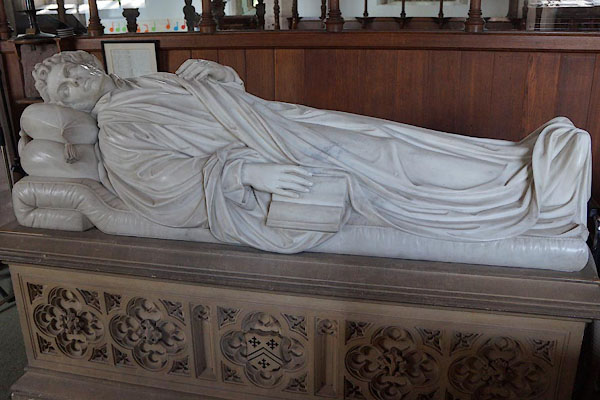
CBA75.jpg Memorial of Robert Southey in the church.
(taken 9.7.2014)
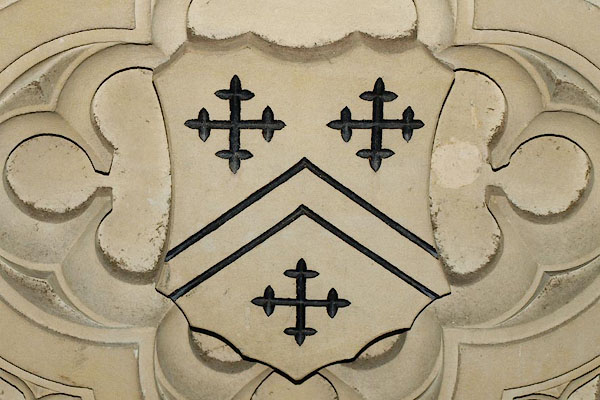
BRA48.jpg Coat of arms, Robert Southey, on his memorial.
(taken 9.7.2009)
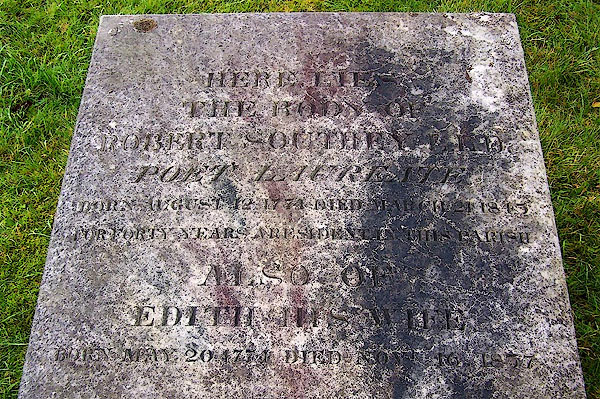
BJX86.jpg The grave of Robert Southey:-
"HERE LIES THE BODY OF ROBERT SOUTHEY L.L.D. POET LAUREATE / BORN AUGUST 12 1774 DIED MARCH 21. 1843 / FOR FORTY YEARS A RESIDENT IN THIS PARISH / ALSO OF EDITH HIS WIFE BORN MAY 20 1774 DIED NOVR 16 18[3]7" Restored by the government of Brazil.
(taken 14.10.2005)
item:- memorial
 goto source
goto sourcePage 83:- "... his [Southey's] monument in Crosthwaite Church;- a recumbent statue by Lough,- the inscription being written by Wordsworth. ..."
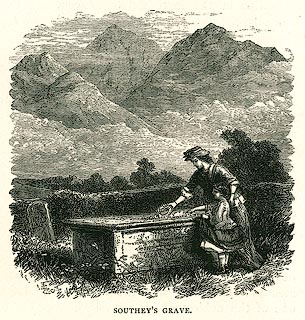 click to enlarge
click to enlargePR0334.jpg
On page 157 of The English Lakes.
printed at bottom:- "SOUTHEY'S GRAVE."
item:- Dove Cottage : 2008.107.334
Image © see bottom of page
item:- memorial
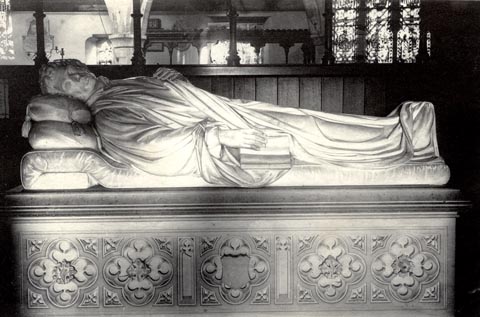 click to enlarge
click to enlargeHB0460.jpg
stamped at reverse:- "HERBERT BELL / Photographer / AMBLESIDE"
item:- Armitt Library : ALPS119
Image © see bottom of page
item:- gravestone
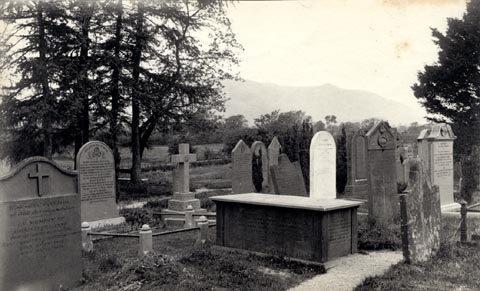 click to enlarge
click to enlargeHB0459.jpg
internegative at lower right:- "H. Bell"
stamped at reverse:- "HERBERT BELL / Photographer / AMBLESIDE"
item:- Armitt Library : ALPS118
Image © see bottom of page
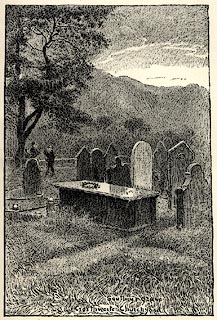 click to enlarge
click to enlargePR1620.jpg
Tipped in opposite p.246 of Through the Wordsworth Country, by William Knight.
printed at lower centre:- "Southey's Grave / Crosthwaite Churchyard"
item:- JandMN : 382.50
Image © see bottom of page
 goto source
goto sourceGentleman's Magazine 1849 part 1 p.377 "..."
"But, rich and pleasant to behold, and wooing to high devotional feeling, as the interior is, that which crowns it with transcendent interest is the monument of the late Robert Southey, whose mind, an Argosy laden with the treasures of wisdom, and whose life, all virtue, through the long years of his residence, had knelt in lowly-minded piety and prayer within these sacred walls, the majesty of intellect, and innocence chastened by the spirit of religion, humbling itself, to quote his"
 goto source
goto sourceGentleman's Magazine 1849 part 1 p.378 "own affecting expression, under the soul-touching truth "that they who are wise unto salvation know feelingly when they have done best that their best works are worth nothing." With a reverence therefore for intellectual greatness, especially when devoted, as its mighty powers ever were, to the advantage and instruction of mankind, Mr. Stanger was further desirous that an appropriate memorial should be placed inside the church, to perpetuate the resemblance of one who, as characterized in the heartfelt panegyric of one of his noble admirers, was so "splendid an instance of a poet, a philosopher, an historian, and even a statesman, chastened and yet elevated by the spirit of the gospel." This, it was especially felt, would be a dignified tribute of regard in the place where his genius, by giving to the things and objects around an interest beyond their own, had sanctified the locality in the associations of his sympathetic and admirimng fellow-countrymen. With this object a subscription was opened for the purpose of defraying the cost at the estimated expense of 400l. in Caen stone of a tomb and effigy. Subsequently, however, it was decided upon that the figure should be sculptured in the beautiful though more costly material of Carrara marble, at the increased charge of 1,100l. A numerous list of subscribers, (whose subscriptions, however, being far from sufficient to cover the entire expense of the monument, have left a considerable deficit, which, it is understood, will fall upon the munificent restorer of the church,) anxious to mark their sense of the genius and virtues of the man, having been obtained, the execution of the memorial was confided to the celebrated sculptor Mr. Lough, whose liberality of feeling, under the circumstances, has entitled him to no little applause, and from his hand has thus proceeded the monument of one who occupies so prominent a place in the history of the literature of his country."
"The situation selected for it is in the south aisle of the chancel, opposite the door, and close to the oaken screen which separates the chancel from its southern aisle. The altar tomb is of Caen stone, the sides of which are divided into five square compartments or panels. Four of these have their centres enriched with carved leaves of different kinds, surrounded by double foliated circles, and the corners of each panel are likewise decorated with ornaments of the same description on a smaller scale. The centre of the middle panel alone displays a vacant shield, intended for the armorial escutcheon of the deceased, and the ends of the tomb, devoid of other embellishment, are filled only with the inscription and lines hereafter recorded. On the top reclines upon a couch, the head and shoulders supported on double tasseled cushions, the full-length effigy, clad in academic robes, of the late laureate. The left hand rests upon the bosom, and the face, turned towards the spectator, wears an expression of meditation, as if musing on the contents of the open volume, which, in the intensity of mental abstraction, has, together with the hand that held it, dropped listlessly by the side. The position best adapted for viewing the figure is in the first seat next the wall, on the left-hand side after passing the chancel door. From thence, in the judgment of those relatives and friends by whom he was most intimately known, the features and character of expression are beheld with the most truthful effect, and this is especially the case when the low-arched door that leads into the aisle is opened, and a ray from the sun, streaming in upon the gloom, casts a brilliancy across the chancel and its aisles, and, bringing into bold distinctness and relief the prominent lineaments of the face and figure, a picture is displayed, which for concentrated beauty and effect is eminently affecting. The west end of the tomb bears this inscription:"
 goto source
goto sourceGentleman's Magazine 1849 part 1 p.379 ""Sacred to the memory of Robert Southey,
whose mortal remains are interred in the adjoining churchyard.
He was born at Bristol,
August XII, M.DCC.LXXIV,
and died, after a residence of nearly XL years, at Greta Hall,
in this parish, March XXI, M.DCCC.XLIII.
This monument was erected by friends of Robert Southey.""
"At the east end of the tomb are the following lines from the muse of Wordsworth, his friend in life, and successor to the crown of bays, who, with his son-in-law, Mr. Quillinan, stood in sorrow by the grave of their brother poet in the north side of the cemetery."
"Ye hills and vales, whose beauty hither drew
The poet's steps, and fixed him here, on you
His eyes have closed! And ye, loved books, no more
Shall Southey feed upon your precious lore,
To works that ne'er shall forfeit their renown
Adding immortal labours of his own.
Whether he traced historic truth with zeal,
For the State's guidance, or the Church's weal,
Or Fancy, disciplined by studious art,
Informed his pen, or wisdom of the heart,
Or judgments sanctioned in the patriot's mind
By reverence for the rights of all mankind,
Wide were his aims, yet in no human breast
Could private feelings find a holier nest.
His joys, his griefs, have vanished as a cloud
From Skiddaw's top, but he to heaven was vowed."
"During the celebration of that portion of the funeral service which is appointed to be read at the grave one of those trivial incidents occured which fall with such creative effect upon a feeling and poetic mind. It was wild and dreary weather in the early spring, before the trees had yet ventured to shew their tender leaflets, or the heather on the tall fells to protrude its first green tufts above their crests of snow. All was bleak, and chill, and desolate, as the hearts of the mourners who drooped in sadness above the minstrel's bier. The day, both before and after the obsequies, was full of gloom and tempest, yet, during that part of the solemn rites alluded to, the storm seemed suddenly to lull, and die away in sobs of fitful quietude. The rain ceased to beat, the clouds to threaten, and a deep stillness fell over the whole scene. A cheering ray of sunshine struggled through the the murky atmosphere, and two small birds perched upon a tree which then overhung the retired corner selected for the last house of mortality, unscared by the presence of the sorrowing train, warbled with tiny pipe their "wood-notes wild." The requiem of genius thus chanted by those "blossoms of the air," as some sweet bard has so poetically called them in his own melodious strain, was a fact every way too graceful in sentiment for the imagination of a poet to overlook, and it consequently gave occasion to some verses by Mr. Quillinan, which, it is to be regretted, the limits assigned to this paper preclude introducing here."
"..."
 goto source
goto sourceGentleman's Magazine 1849 part 1 p.494 "April 2, 1849."
"MR. URBAN,"
"A COPY of the inscription of the gravestone of the Southey family in the north-west corner of the churchyard, seems almost essential to the completeness of the very beautiful account of Crosthwaite Church with which two of the late numbers of the Magazine have been enriched. I send it you therefore as it was transcribed in August, 1839."
"The Lord gave and the Lord / hath taken away, blessed / be the name of the Lord."
"Sacred to the memory / of / EMMA SOUTHEY, / who departed in May, 1809, aged / 14 months."
"And of HERBERT SOUTHEY, who / departed April 17, 1826, / in the tenth year of his age."
"Also of GEORGE FRICKER their / uncle, aged 26, 1814."
"Also of ISABEL SOUTHEY their / sister, who departed on the / 16 of July, 1826, aged / 13 years."
"Also EMMA SOUTHEY their / mother, who departed / in Nov. 1837, aged 63."
"Requiescat in pace."
"I remember the sexton pointing out the seat which the poet occupied in the church, where, according to him, he sat absorbed in meditation, and abstracted from everything but the course of the service in which he was taking part."
"Yours, &c. J.H."
